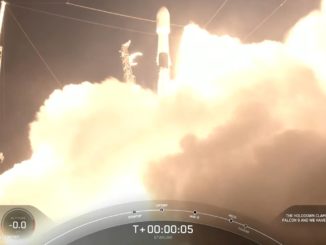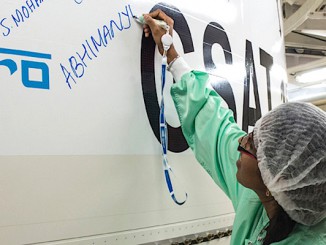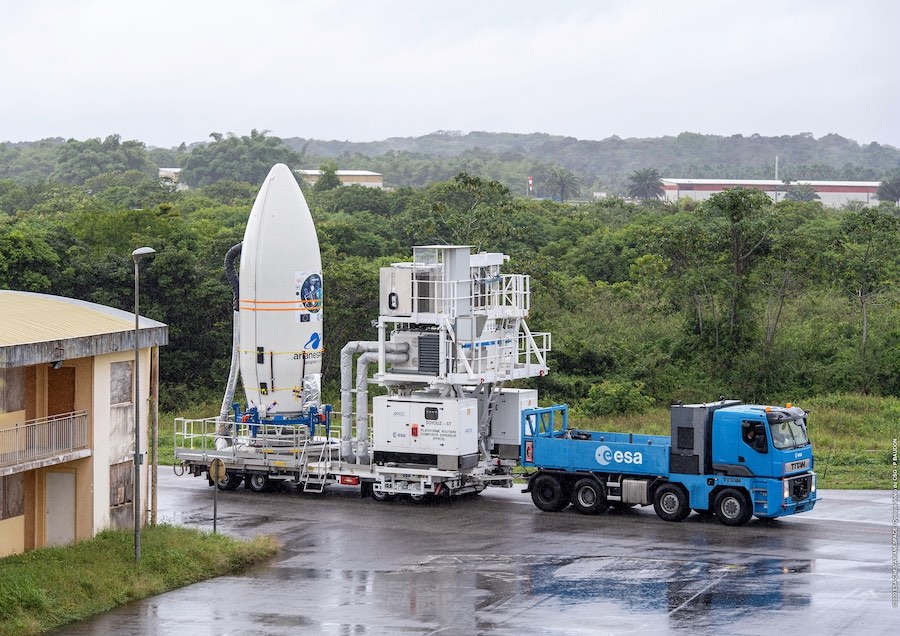
The first launch of an Italian-made Vega rocket since an in-flight failure nearly one year ago has been postponed to no earlier than Monday night due to unfavorable upper level winds over the Vega launch base in Kourou, French Guiana.
The four-stage rocket was scheduled to take off from French Guiana on Thursday night, but officials said late Wednesday that the mission would be pushed back until at least Saturday night. Sources said Thursday that the winds aloft are not expected to improve enough to allow launch until no earlier than Monday night.
When it takes off, the Vega launcher will carry 53 small satellites into orbit on the first large-scale rideshare mission for Arianespace, the French company that oversees Vega sales and launch operations.
The 53 spacecraft mounted on top of the 98-foot-tall (30-meter) come from 21 customers in 13 countries, including European Space Agency member states, the United States, Canada, Argentina, Thailand and Israel.
Whatever day the mission launches, liftoff of the Vega rocket from the Guiana Space Center is targeted for 9:51:10 p.m. EDT (10:51 p.m. French Guiana time; 0151 GMT).
The Vega rocket is set for its first launch since July 2019, when a failure on the Vega’s solid-fueled second stage motor led to the destruction of the Falcon Eye 1 military reconnaissance satellite for the United Arab Emirates.
Avio, the Italian company that builds most of the Vega rocket, said an investigation into the July 2019 launch failure concluded super-hot gas from burning solid propellant impinged on the structure of the Vega rocket’s Zefiro 23 second stage on the mission last July, resulting in a “thermo-structural failure” on the second stage’s forward dome.
The hot gas, which burns at more than 5,000 degrees Fahrenheit (3,000 degrees Celsius), damaged or burned through the carbon fiber structure on the second stage. The structural failure led to the in-flight breakup of the launch vehicle with the UAE’s Falcon Eye 1 spy satellite.
According to Giulio Ranzo, Avio’s CEO, investigators determined a “manufacturing anomaly” slipped through Avio’s quality control checks.
“We had thermal protection (on the second stage) where the thickness was perhaps less than one millimeter short, so we had a very, very tiny deviation that was undetectable to all the quality checks,” Ranzo said in March during an interview with Spaceflight Now.
“So what we have done is we have greatly improved the technologies to allow for the manufacturing quality controls — using not only ultrasound but also digital radiography — in a much finer way with respect to work we used to do in the past,” Ranzo said.
Avio pulled hardware from the company’s Zefiro 23 production line in Italy, ran it through the improved quality control checks, and successfully test-fired the rocket motor at a test site in Sardinia.
“We test-fired a Zefiro 23 without any modifications,” Ranzo said. “But we picked one from production that we subjected to a much deeper quality control. So what we tested was our ability to detect a manufacturing production defect at a much finer level.”
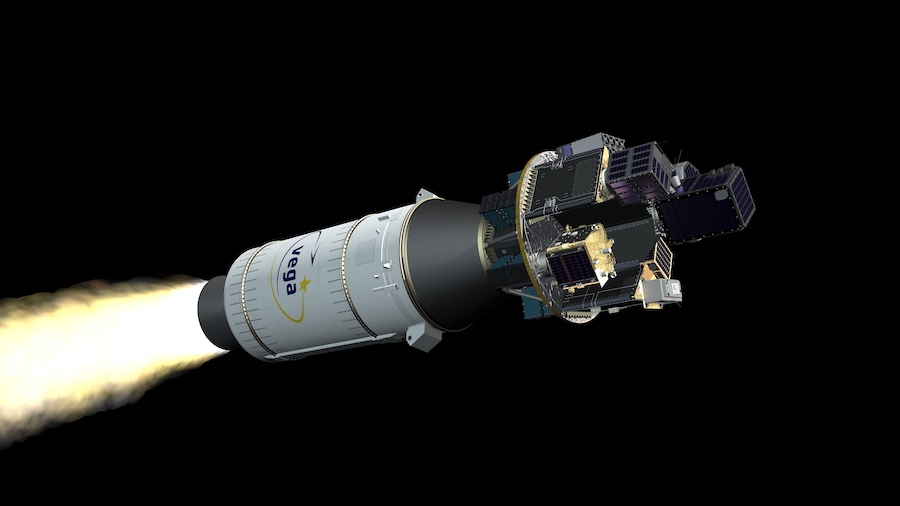
Ranzo said Avio also added extra thermal insulation on the Zefiro 23 second stage motor.
“It’s probably not necessary, but we increased the safety margin,” he said. “So we are now approaching the flight with much better comfort with respect to safety.”
Engineers also modified parts of the Vega’s telemetry, flight safety and self-destruct devices, Ranzo said.
The Vega rocket had amassed 15 straight successful launches since its debut flight in February 2012, but the failure last year showed the launch vehicle’s reliability could be improved.
“We took the opportunity to increase the safety margin at a general level all across the launcher,” he said. “So we introduced some video cameras on-board to acquire more data and other sensors to continue monitoring exactly what happens, and continue learning as we go.
“I would say what came out is a launcher that is better and is updated with respect to what we had in the past, not only for the Zefiro 23 but also beyond.”
The rideshare mission set for launch on the Vega rocket is the first flight of the Small Spacecraft Mission Service, or SSMS, platform designed to accommodate dozens of microsatellites and CubeSats on a single launch.
Development of the SSMS carbon fiber dispenser was started by the European Space Agency in 2016. The first SSMS launch, designated as a “proof of concept” flight, will carry 53 spacecraft into orbit ranging in mass between about 2 pounds (1 kilogram) and 330 pounds (150 kilograms), according to Arianespace.
The mission will carry more satellites into orbit than any previous European rocket launch. The record number of satellites ever carried on a single rocket launch is 104, a mark set in 2017 on a flight by India’s Polar Satellite Launch Vehicle.
“We have SuperDoves from Planet, we have Spire on-board, we have GHGSat from Canada, we have some from the European Commission,” Ranzo said in an interview in March with Spaceflight Now. “We have a whole bunch of customers coming from all over the world, so not bad. It’s fully loaded. We basically have no room left for additional payloads. It’s the first time in Europe that we do a massive rideshare which has such a different in satellites from the size of one to the size of another.”
Avio and Arianespace are planning more SSMS rideshare missions, beginning in late 2021 or early 2022 with the SSMS 2 mission on a Vega C rocket. The Vega C is an upgraded version of the Vega rocket scheduled to debut in early 2021.
With three solid-fueled stages and a liquid-fueled upper stage, the Vega rocket can loft a payload of up to 3,300 pounds into a polar sun-synchronous orbit with an altitude of 435 miles (700 kilograms). It can carry heavier cargo than commercial small satellite launchers, such as Rocket Lab’s Electron vehicle, but the Vega’s lift capacity falls short of bigger rockets like SpaceX’s Falcon 9.
The Vega rocket’s rideshare launch service will compete with smallsat launch companies, India’s PSLV, and companies like SpaceX, which announced last year a renewed focus on contracts to carry small satellites into orbit on rideshare launches using Falcon 9 rockets.
SpaceX said Wednesday it had signed up to launch more than 100 small spacecraft on multiple Falcon 9 rockets since it announced the rideshare launch program in August 2019. Some of those satellites will launch as secondary payloads on Falcon 9 missions delivering Starlink Internet satellites to orbit, and others will ride to space on Falcon 9 missions dedicated to carrying clusters of customer smallsats into orbit.
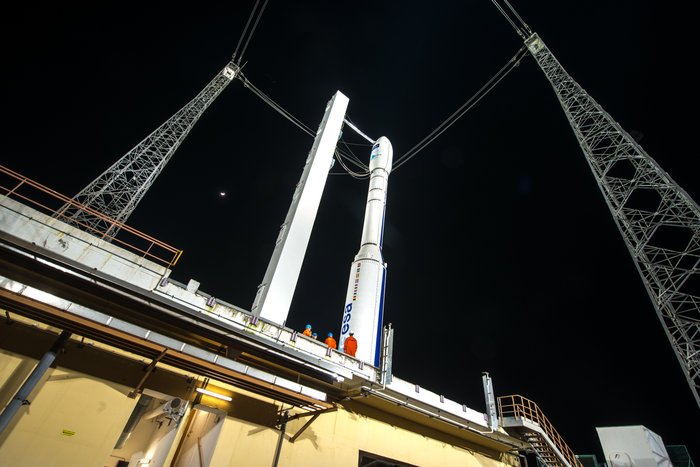
The Vega launch next week will also mark the first liftoff from the European-run spaceport in French Guiana since Feb. 18, when Arianespace launched a heavy-lift Ariane 5 rocket.
Arianespace and Avio planned to launch the Vega rocket’s SSMS rideshare mission March 23, but officials suspended launch preparations at the Guiana Space Center in mid-March due to the coronavirus pandemic.
Teams from Europe needed to ready the Vega rocket and its payloads for flight returned to French Guiana in May to resume the launch campaign. Officials introduced physical distancing measures and required workers to wear face coverings and other personal protective equipment, while some workers took part in launch preparations remotely utilizing video conferencing for inspections and pre-flight reviews.
Public launch viewing sites at the Guiana Space Center remain closed due to the threat from the COVID-19 viral disease.
Email the author.
Follow Stephen Clark on Twitter: @StephenClark1.


